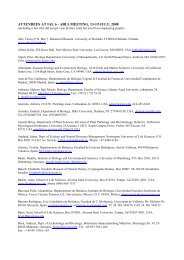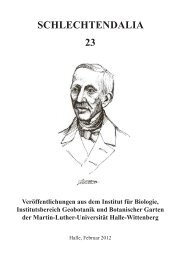international lichenological - International Association for Lichenology
international lichenological - International Association for Lichenology
international lichenological - International Association for Lichenology
You also want an ePaper? Increase the reach of your titles
YUMPU automatically turns print PDFs into web optimized ePapers that Google loves.
20 INTERNATIONAL LICHENOLOGICAL NEWSLETTER 42 (1)<br />
Ingvar Kärnefelt 65 years - a birthday tribute<br />
On the 11th of August, prof. Ingvar Kärnefelts 65th birthday was celebrated with<br />
an issue of The Lichenologist as a tribute, including contributions from all of his<br />
<strong>lichenological</strong> PhD students at Lund University in Sweden. During the day, we<br />
���������������������������������������������������������������������������������<br />
evening. The issue begins with a presentation of Ingvars <strong>lichenological</strong> activities,<br />
with taxonomic work on cetrarioid lichens and within the family Teloschistaceae. He<br />
has also played an active role in IAL, organizing IAL2 in Hemmeslöv, Sweden and<br />
serving as the president 1992–96. He has supervised eight PhD students in lichenology<br />
and is now the head of the Biological Museums in Lund. The introduction is followed<br />
by a historical overview of lichenology in Lund. This overview, written by Patrik<br />
Frödén, includes early contributions from naturalists and botanists, such as Anders<br />
Jahan Retzius, Erik Acharius and Elias Fries, as well as recent <strong>lichenological</strong> works<br />
by Ove Almborn, Hans Runemark, Ingvar himself and his PhD students. Ulf Arup<br />
and Elin Åkelius present a taxonomic revision, based on morphometry and DNAanalyses,<br />
of Caloplaca herbidella and C. furfuracea.The taxa are shown to be separate<br />
species, and the closely allied C. coralliza is also described as new to science. Stefan<br />
Ekman describes Bacidia rosellizans as new to science, a species from restricted<br />
localities in North America and northern Europe. It is closely allied to B. rosella,<br />
but differs in minor morphological and anatomical characters and occurs on more<br />
acid bark. Arne Thell and coworkers present a phylogeny of the cetrarioid lichens.<br />
Allocetraria, Cetraria s.str., Cetrariella and Vulpicida <strong>for</strong>m a strongly supported<br />
clade, while Cetraria s.lat., Flavocetraria and Tuckermannopsis are polyphyletic.<br />
Martin Westberg, Patrik Frödén and Mats Wedin present a monograph of the South<br />
American genus Placomaronea, including a phylogeny of Candelariaceae based on<br />
molecular data. Three new species, among others P. kaernefeltii, are described and<br />
the genus is also shown to occur in southern Africa. Louise Lindblom discusses the<br />
effect of sample sizes in recording haplotypes of Xanthoria parietina, both within<br />
and among populations. She points at the importance of pilot studies to determine<br />
the appropriate sample sizes in such studies. Lars Fröberg, Mats Niklasson, Heidi<br />
Paltto, Tommy Knutsson and Thomas Johansson have studied the lichen diversity of<br />
the dwarf shrub Helianthemum oelandicum, which occurs in calcareous grasslands<br />
on the Baltic island of Öland. Phorophyte age was determined by ring counting<br />
and was correlated with lichen species number in living phorophytes. Furthermore,<br />
����� ������������ ������� ������������� ����� ������� �������� ����� ������� ������ ����<br />
Eric Mattsson, Anne-Charlotte Hansson and Louise Lindblom studied the genetic<br />
variation of Hypogymnia physodes and H. tubulosa in localities around the Baltic Sea.<br />
Haplotypes of H. physodes did not show any differences in phorophyte preferences.<br />
However, a network pattern of H. physodes was revealed by a statistical parsimony<br />
analyse, indicating recombination within the ITS region of this primarily clonally<br />
reproducing species. Håkan Lättman and coworkers (including his supervisor J.-E.<br />
Mattson) present an estimation of generation time of 25–30 years in Cliostomum<br />
corrugatum, determined by measures of sizes of thalli and ascomata.






